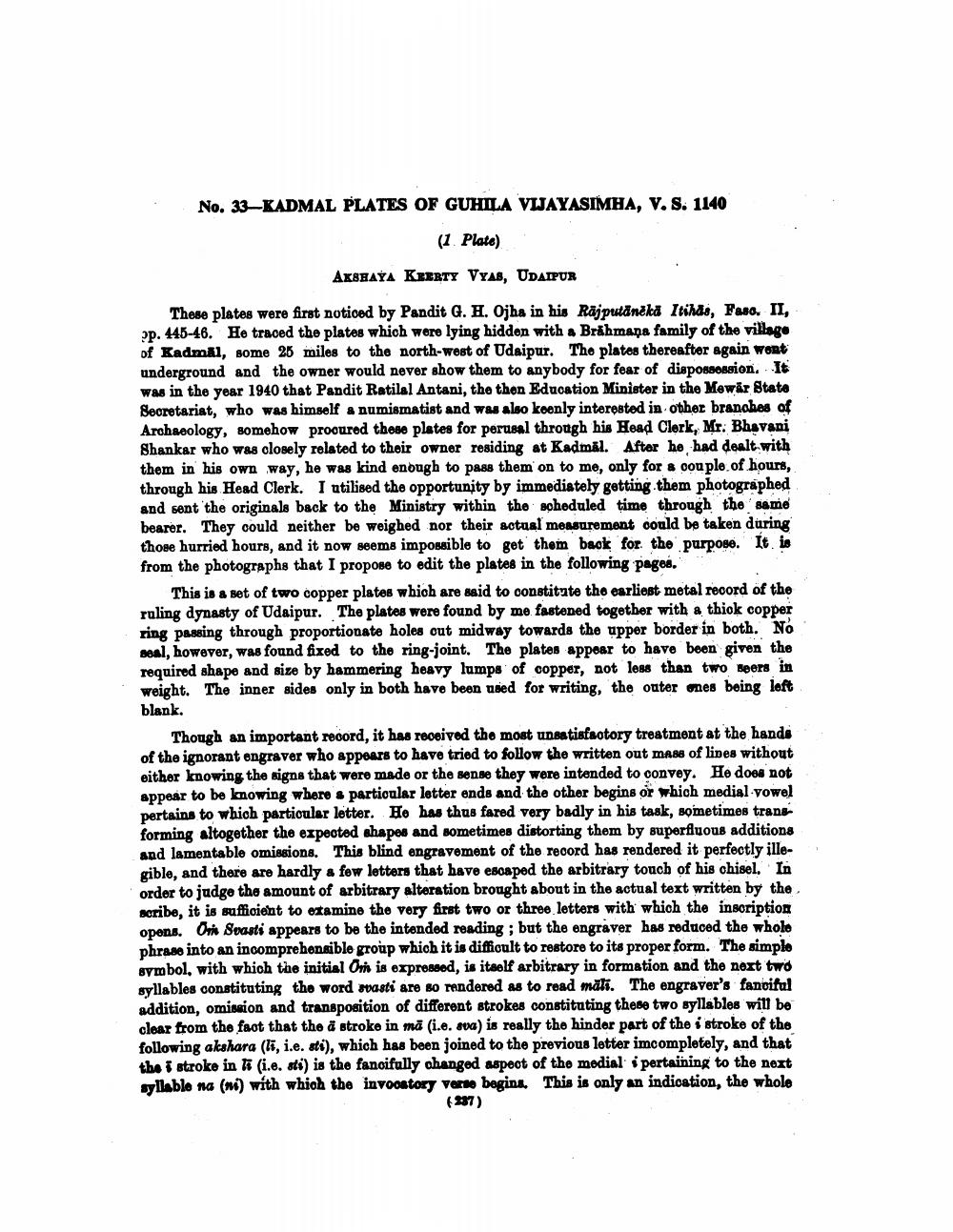________________
No. 33–KADMAL PLATES OF GUHILA VIJAYASIMHA, V. S. 1140
(1. Plate)
AKSHAYA KEERTY VYAs, UDAIPUR
These plates were first noticed by Pandit G. H. Ojha in his Rājputāneka Itihas, Paso. II, 2p. 445-46. He traced the plates which were lying hidden with a Brahmana family of the village of Kadmål, some 25 miles to the north-west of Udaipur. The plates thereafter again went underground and the owner would never show them to anybody for fear of dispossession. It was in the year 1940 that Pandit Ratilal Antani, the then Education Minister in the Mewar Stato Secretariat, who was himself a numismatist and was also koenly interested in other branches of Archaeology, somehow procured these plates for perusal through his Head Clerk, Mr. Bhavani Shankar who was closely related to their owner residing at Kadmål. After he had dealt with them in his own way, he was kind enough to pass them on to me, only for a couple of hours, through his Head Clerk. I utilised the opportunity by immediately getting them photographed and sent the originals back to the Ministry within the scheduled time through the same bearer. They could neither be weighed nor their actual measurement could be taken during those hurried hours, and it now seems impossible to get them back for the purpose. It is from the photographs that I propose to edit the plates in the following pages,
This is a set of two copper plates which are said to constitute the earliest metal record of the ruling dynasty of Udaipur. The plates were found by me fastened together with a thiok copper ring passing through proportionate holes out midway towards the upper border in both. No seal, however, was found fixed to the ring-joint. The plates appear to have been given the required shape and size by hammering heavy lumps of copper, not less than two Beers in weight. The inner sides only in both have been used for writing, the outer mes being left blank.
Though an important record, it has received the most unsatisfactory treatment at the hands of the ignorant engraver who appears to have tried to follow the written out mass of lines without either knowing the signs that were made or the sense they were intended to convey. He does not appear to be knowing where s particuler letter ends and the other begins or which medial vowel pertains to which particuler letter. Ho has thus fared very badly in his task, sometimes trans forming altogether the expected shapes and sometimes distorting them by superfluous additions and lamentable omissions. This blind engravement of the record has rendered it perfectly illegible, and there are hardly a few letters that have escaped the arbitrary touch of his chisel. In order to judge the amount of arbitrary alteration brought about in the actual text written by the
cribe, it is sufficient to otamine the very first two or three letters with which the inscription opens. Ori Spasti appears to be the intended reading ; but the engraver has reduced the whole phraso into an incomprehensible group which it is difficult to restore to its proper form. The simple symbol, with which the initial Ori is expressed, is itself arbitrary in formation and the next two syllables constituting tho word masti are 80 rendered as to read mali. The engraver's fanciful addition, omission and transposition of different strokes oonstituting these two syllables will be clear from the fact that the a stroke in mā (i.e. wa) is really the hinder part of the stroke of the following akshara (li, i.e. sti), which has been joined to the previous letter imcompletely, and that the 1 stroke in ti (i.e. sti) is the fancifully changed aspect of the medial pertaining to the next syllablo na (m) with which the invocatory verte begins. This is only an indication, the whole
(287)




